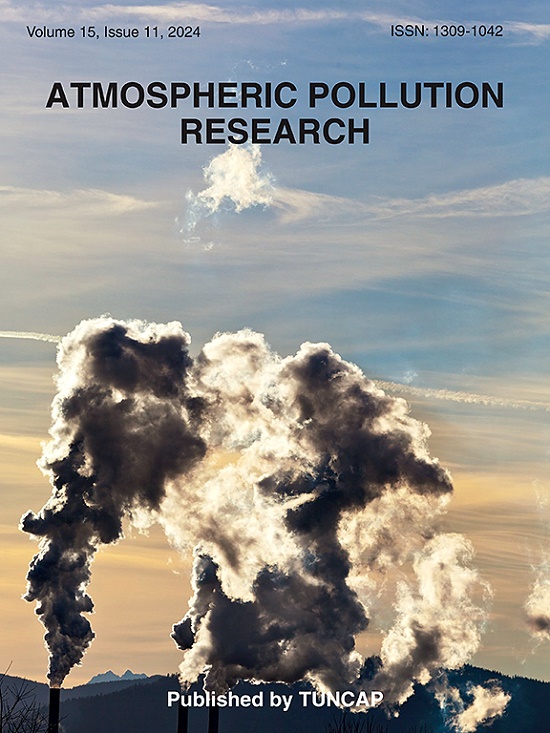Multi-scale characteristics and statistically associated factors of ozone pollution in Hangzhou based on machine learning
IF 3.9
3区 环境科学与生态学
Q2 ENVIRONMENTAL SCIENCES
引用次数: 0
Abstract
Ozone pollution poses a significant air quality challenge in Hangzhou in recent years. This study investigated the multi-scale characteristics and statistically associated factors of ozone pollution in Hangzhou based on O3 data from 12 monitoring stations in the city from 2018 to 2022, along with data on other pollutants and meteorology. The analysis utilized the PAM (Partitioning Around Medoids) clustering method, KZ (Kolmogorov–Zurbenko) filtering method, and XGBoost (eXtreme Gradient Boosting) combined with the SHAP (Shapley additive explanations) model. The results indicate that: (1) Clustering of the MDA8-O3 (Maximum Daily 8-Hour Average O3) data from monitoring stations using PAM reveals that Hangzhou can be divided into three sub-regions: west, central, and east, with varying degrees of ozone pollution from low in the west to high in the east. (2) Decomposition of the MDA8-O3 concentration time series into long-term, seasonal, and short-term components highlights that the short-term components primarily drive the fluctuations in the original sequence. (3) At both temporal and spatial scales, disparities in the statistically associated factors of ozone pollution exist. Temporally, temperature and relative humidity dominate seasonal and short-term components, while long-term components are statistically associated with both temperature and long-term emissions. Spatially, temperature is the main factor in the west, but diminishes in the central and eastern regions, where other pollutants become more influential. Regional differences in emission sources near monitoring sites also affect statistically associated factors. The findings of this study can offer valuable insights for developing targeted strategies for ozone pollution control in Hangzhou.

基于机器学习的杭州臭氧污染多尺度特征及统计相关因子
近年来,臭氧污染对杭州的空气质量构成了重大挑战。基于2018 - 2022年杭州市12个监测站的O3数据,以及其他污染物和气象数据,研究了杭州市臭氧污染的多尺度特征及其统计相关因素。分析采用了PAM (Partitioning Around Medoids)聚类方法、KZ (Kolmogorov-Zurbenko)滤波方法和XGBoost (eXtreme Gradient Boosting)结合SHAP (Shapley additive explanatory)模型。结果表明:(1)利用PAM对杭州市各监测站的MDA8-O3 (Maximum Daily 8-Hour Average O3)数据进行聚类分析,发现杭州市可划分为西、中、东3个分区,臭氧污染程度由西低到东高不同;(2)将MDA8-O3浓度时间序列分解为长期、季节和短期三个分量,表明短期分量主要驱动原序列的波动。(3)在时间和空间尺度上,臭氧污染的统计相关因子存在差异。在时间上,温度和相对湿度在季节和短期分量中占主导地位,而长期分量在统计上与温度和长期排放均相关。在空间上,温度是西部地区的主要影响因素,但在中部和东部地区减弱,其他污染物的影响更大。监测点附近排放源的区域差异也会影响统计相关因子。研究结果可为制定有针对性的杭州臭氧污染控制策略提供参考。
本文章由计算机程序翻译,如有差异,请以英文原文为准。
求助全文
约1分钟内获得全文
求助全文
来源期刊

Atmospheric Pollution Research
ENVIRONMENTAL SCIENCES-
CiteScore
8.30
自引率
6.70%
发文量
256
审稿时长
36 days
期刊介绍:
Atmospheric Pollution Research (APR) is an international journal designed for the publication of articles on air pollution. Papers should present novel experimental results, theory and modeling of air pollution on local, regional, or global scales. Areas covered are research on inorganic, organic, and persistent organic air pollutants, air quality monitoring, air quality management, atmospheric dispersion and transport, air-surface (soil, water, and vegetation) exchange of pollutants, dry and wet deposition, indoor air quality, exposure assessment, health effects, satellite measurements, natural emissions, atmospheric chemistry, greenhouse gases, and effects on climate change.
 求助内容:
求助内容: 应助结果提醒方式:
应助结果提醒方式:


